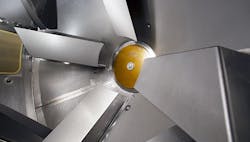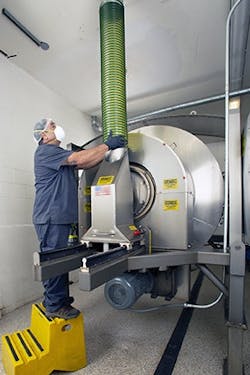Processing Equipment: Tumbling Speeds Supplement Blending
Systemic Formulas, an Ogden, Utah-based manufacturer of herbal blends and powdered vitamins, sells directly to homeopaths, naturopaths, nutritional consultants, and other healthcare professionals. “Our products are complicated, with multiple ingredients and more than 150 different SKUs,” says production manager Spencer Hansen. The company offers capsules, powders, liquids and sachet daily-dose packaging.
“We’re a niche player in the herbal and vitamin/mineral supplement industry,” he notes. “Systemic Formulas is distinct because our products are unique and of the highest quality. It follows that our operators and equipment need to be the best.”
Equipment Upgrade
As its product line grew, Systemic Formulas streamlined production to meet demand by replacing its paddle mixer with a rotary batch mixer. This switch from agitation to tumbling cut mixing and cleaning time by 80%.
Installation took place in Sept. 2019 — as did disassembly and removal of the old unit. The rotary batch mixer occupies the same room and is gravity fed from the room above, as was the paddle mixer.
The plant operates one shift per day, five-to-seven days per week, depending upon demand. “We create one or two batches in an eight-hour shift, with a stringent cleaning protocol required between batches,” explains Hansen.
Product recipes contain 15–60 raw materials, including vitamins, minerals, enzymes, RNA/DNA tissue factors, amino acids and botanicals. With so many products, from adrenal health to macular degeneration and weight management supplements, Systemic Formulas’ batch production process must provide both flexibility and accuracy.
A hammer mill reduces materials to the desired particle size. They then are transported in 44-gal (194-l) lined food-handling containers to the gravity-fed rotary batch mixer, a 40-ft3 (1,132-l) model 700-TS-40-SS from Munson Machinery (Figure 1).
Batch sizes vary from as small as 100 lb (45 kg) to as large as 1,147 lb (521 kg); the average batch weighs 880 lb (400 kg) and yields 800,000 ½-g capsules that get packaged into bottles.
Better Performance
Batch blending takes four-to-six minutes versus 20 minutes for the paddle mixer. “No matter the particle size, it does not under- or over-mix, providing the uniform consistency we need,” says Hansen.
The unit’s internal mixing flights impart a four-way mixing action that tumbles, folds, cuts and turns the material gently, without the shear of agitated machines. “These delicate ingredients are thoroughly blended without damage,” he notes.
To add liquids, an optional pressure pot with an internal atomizer sprays a mist of the particular ingredient — hemp, wintergreen, grapeseed or other oil — onto a moving bed of material for rapid and uniform distribution.
“The aerating system allows us to add oils without wet spots or clumping,” comments Hansen. “Air gaps constantly move the surface area so no snowball-sized clumps occur. The result is a uniform yield that we could not achieve with our paddle mixer.”
Figure 1. Unit blends ingredients in batches that range from 100 lb to 1,147 lb.
At the conclusion of a blending cycle, the drum continues to rotate, causing the internal flights to elevate the material toward and through a plug gate valve; this avoids stratification associated with discharging of static batches. “The mixer completely discharges,” says Hansen, eliminating material waste and reducing cleaning time.
“Between each batch, we treat the mixer like a big washing machine,” Hansen points out. It is prewashed, soaped down and rinsed. This is followed by a second soap cycle with agitation balls and then drying with clean rags or towels. The unit next is rescrubbed, rinsed, sanitized and air dried, after which it is wiped down with alcohol, ready for the next batch.
“Cleaning took 2½–3 hours with our old 32-ft3 (906-l) mixer, which operated like a cement truck with paddles,” recalls Hansen. “With the rotary batch mixer, we pared cleaning cycle time down to 30 minutes. The large discharge gate and multiple doors give us easy access for final wipe-down cleaning.”
Rigorous Quality Control
Regulated by the U.S. Food and Drug Administration, Systemic Formulas must trace the lot number of the finished product back to the origin of the raw materials. “Having our own in-house lab gives us control over raw material vendors,” stresses Hansen. “Our CEO is a PhD biochemist, so our sourcing agents must find the best vendors of specialty materials. Our purchasers even understand harvest cycles to obtain the purest herbs for our product,” he notes.
STEPHEN J. KNAUTH is marketing and technical manager for Munson Machinery Co., Utica, N.Y. Email him at [email protected].

